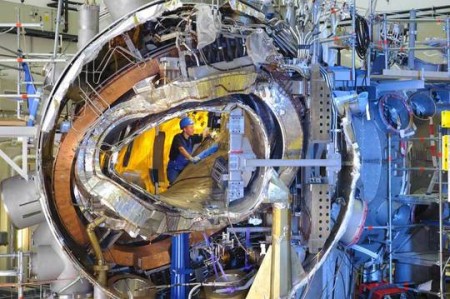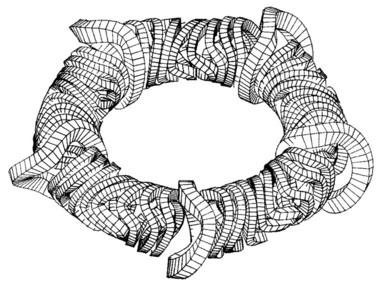November 4, 2015 – Hot fusion, cold fusion…the promise of sustainable, commercial fusion reactors remain enigmatic. We just can’t the architecture quite right whether we are talking about tokamaks like the ITER project in France, or all the “so-called” successful demonstrations of cold fusion devices like those invented by Andrea Rossi. In August I reported that MIT was working on a new fusion reactor concept. In October 2014 I described the research Lockheed Martin was doing with small fusion reactor designs.
Now comes something new in the fusion world. That something is a stellarator. Unlike a tokamak, the stellarator abandons symmetry in favor of twisted external coils that can be used to create an optimal magnetic field. The Max-Planck Institute for Plasma Physics in Germany has been experimenting with stellarators for more than a decade, and the scientists and engineering team have come up with an optimal magnetic field called the Wendelstein 7-X (see configuration below), a simpler solution than the tokamak.
What looks like cord wrapping are in fact magnets which confine the hot plasma. They are composed of flexible copper strands reinforced by fiberglass bands and synthetic resins. Embedded in the copper are superconducting materials made of niobium-titanium. The coolant is liquid helium which flows between the individual wires. The entire reactor is enclosed in helium-tight aluminum. Within the magnetic coils the plasma gets contained in a vacuum-tight vessel made from high-strength steel. Special collector plates protect the walls from escaping particles which are captured and pumped off. During operation the plasma loses particles. The stellarator however can be refueled a number of ways. One way is a pellet accelerator which can inject up to 60 fuel pellets into the plasma at a time.
Back in July of this year Max-Planck tested the magnetic field in the Wendelstein 7-X and it met all expectations for confining a high-temperature fusion plasma. The stage is now set to fire up the beast sometime in the next few weeks. The Wendelstein 7-X is no trivial device. It measures 15.8 meters (52 feet) across and weighs 425 tons. The structure is chilled close to absolute zero and when it is fired the goal will be to sustain the hot plasma for 30 minutes. The end result should be a significant excess of energy output over input.
If it works this will be a game changer. The picture below taken by Wolfgang Filser in November of 2011 shows the interior of the Wendelstein 7-X under construction. The worker visible in the background is surrounded by the twisting form of the stellarator’s magnetic coils. It is easy to see the irregular shape that defines one of the differences between the stellarator and tokamak.


















[…] quite pointless. [28] In August I reported that MIT was working on a new fusion reactor concept. [38] November 4, 2015 Hot fusion, cold fusionthe promise of sustainable, commercial fusion reactors […]